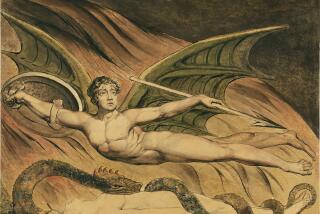Edvard Munch’s ‘The Scream’ goes for $119.9 million at Sotheby’s
NEW YORK -- Sometimes beauty is trumped by the beast. After bullish expectations and an aggressive marketing campaign for an image considered the quintessential expression of modern horror, Sotheby’sNew York sold Edvard Munch’s 1895 “The Scream” for $119.9 million on Wednesday night, setting a record for the most expensive artwork sold at auction.
The top spot was previously held by Picasso’s 1932 “Nude, Green, Leave and Bust” -- a painting of his much-younger lover Marie-Therese Walter that sold at Christie’s in 2010 for $106.5 million.
The identity of the buyer, who was bidding by phone during the 12-minute auction, has not been confirmed. Bidding started at $40 million, with at least five bidders. Rumors before the sale, not confirmed, focused on interest from the royal family of Qatar.
AT THE AUCTION: Can you guess the price?
Munch’s “The Scream” achieved another milestone: It now ranks as the most expensive drawing publicly sold. For this version of “The Scream” -- one of four -- is best described as a crayon or pastel drawing, not a painting, on board. The Munch Museum in Oslo owns a pastel as well as a painted version, while the National Gallery of Norway holds the earliest painting, dated 1893.
And it easily beat out the previous auction record for Munch, also held by Sotheby’s. In 2008, the auction house sold the 1894 Munch painting “Vampire,” a melodramatic image of a red-haired, bare-armed woman kissing a man’s neck, for about $38 million.
Judd Tully, the art-market expert who is editor at large of Art+Auction magazine, said it was hard to identify the potential pool of buyers. “Under a dozen collectors have been identified who would buy something north of $50 million, and the number gets lower as the prices go up,” he said before the sale.
But in the case of such a “powerful and famous image,” he added, “there could be someone outside of that club who has fallen prey to the marketing campaign or just decided they wanted the image.”
The central image in this artwork is the gaping-mouthed, skull-like face and twisting torso that people know so well from reproductions, cartoons and a seemingly endless stream of merchandise, from shower curtains to neckties. The location depicted is Ekeberg Hill, an overlook point in the south of Oslo that was known as the scene of suicides.
Some read the image as a symbol of modern existentialist anguish, expressing fear of a hostile universe and perhaps even anticipating the horrors of the world wars. Others view it more specifically as an expression of personal suffering.
Munch’s mother died of tuberculosis when he was 5; his sister Sophie died when he was 14; his father died when he was 25 and shortly after that his sister Laura was institutionalized.
According to Munch’s biographer Sue Prideaux, Laura was committed to an asylum in Ekeberg for schizophrenia, and from the vantage point depicted in the artwork, you could hear the screams from the asylum patients as well as the animals from a slaughterhouse nearby.
The first owner of the work sold at Sotheby’s was German chicory and coffee mogul Arthur von Franquet, a patron who also owned Munch’s 1892 painting “Girl by the Window,” now at the Art Institute of Chicago. Its second owner was the Berlin banker and art collector Hugo Simon, who sold it through an art dealer around 1937 to Norwegian ship owner Thomas Olsen.
A neighbor of Munch’s in the tiny town of Hvisten who became one of his greatest collectors, Olsen at one point helped the artist hide his works from the Nazis. Thomas’s son Petter, who put the work up for sale at Sotheby’s, has issued a statement saying he will be using the proceeds to finance the creation of a new Munch museum in Hvitsten.
For the months leading up to the sale, Sotheby’s mounted an unprecedented campaign to help ensure that the celebrated image brought an illustrious price. On top of the usual glossy catalog spreads and the increasingly familiar video spots, Sotheby’s also created a limited-edition catalog dedicated solely to “The Scream” with essays by Prideaux and New Yorker magazine writer Adam Gopnik. Along with showing off the drawing at London and New York previews, the auction house also flew it to the homes of interested collectors.
And the previews themselves were dramatic affairs, with “The Scream” spotlighted in an otherwise dark room. “Our ambition was to do something really special to reflect the historic moment,” said Simon Shaw, head of Sotheby’s Impressionist/modern department in New York. “I’ve never had the privilege of handling such a significant and memorable work of art, and I doubt I will have the privilege of doing that again.”
Tully said he hasn’t seen anything like this since the London gallery White Cube’s promotion of the Damien Hirst diamond-encrusted-skull, “For the Love of God,” when hundreds lined up to see the work. “I think maybe Sotheby’s took something from that sale for its marketing machine.”
Tully added that it was particularly hard to estimate the value of this work in advance because it doesn’t fit familiar blue-chip criteria. “It’s an Expressionist work and it’s colorful, and those are two things that are very desirable in the current trophy market. But it’s the oddest trophy -- not that big, and it’s a pastel.”
“A purist of sorts would say that it can’t be that valuable: You can’t call it an oil on canvas, because it’s not either,” he added.
Shaw, on the other hand, stressed that crayon was a perfect choice for the work. “The artist designed “The Scream” to be a new sort of history painting for the godless age: It’s a radically new subject matter for which Munch sought a radically new technique, one with every stroke visible, with no deception, no artifice and total authenticity.”
Shaw would not disclose the financial terms negotiated with the seller, but to land such high-profile consignments the big auction houses will often make a sweetheart deal. Sometimes they will forego a seller’s commission; at times, they also turn over part of the buyer’s premium to the seller.
Whatever the exact arrangement, “The Scream” also paid off in a smaller way for the auction house by drawing more notable artworks to the sale. This sale had a particular strength in Surrealist painting, with several works by René Magritte, a hallucinatory landscape by Salvador Dali, a lurid jungle scene by Max Ernst and a darkly Freudian narrative by Paul Delvaux featuring nude women, a stairway and a tunnel.
The Wednesday auction also contained five other works -- all oil paintings -- by Munch. Shaw confirmed that the two European collections supplying these works for sale agreed to do so only after learning that “The Scream” would be part of the auction. “For some people, the chance of selling alongside one of the great masterpieces in art history is pretty compelling,” Shaw said.
ALSO:
Picasso sets record sale price
An exodus of artwork from Los Angeles
Who will pay $80 million (or so) for Edvard Munch’s ‘The Scream’?
You can follow the writer Jori Finkel on twitter: www.twitter.com/jorifinkel
More to Read
The biggest entertainment stories
Get our big stories about Hollywood, film, television, music, arts, culture and more right in your inbox as soon as they publish.
You may occasionally receive promotional content from the Los Angeles Times.






